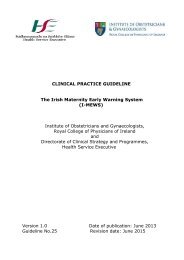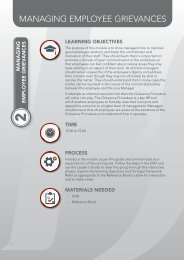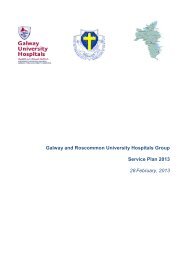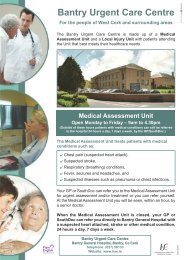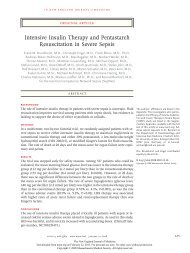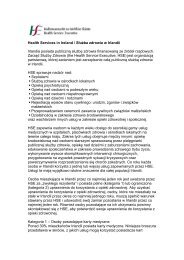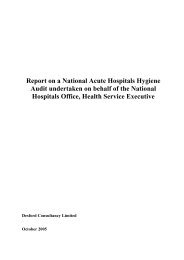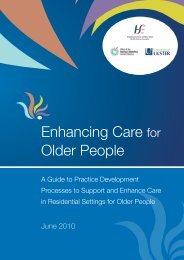4. Hand Hygiene Guideline (HIQA).pdf - Health Service Executive
4. Hand Hygiene Guideline (HIQA).pdf - Health Service Executive
4. Hand Hygiene Guideline (HIQA).pdf - Health Service Executive
Create successful ePaper yourself
Turn your PDF publications into a flip-book with our unique Google optimized e-Paper software.
HSE West Mid-Western Regional Hospitals, <strong>Hand</strong> <strong>Hygiene</strong> <strong>Guideline</strong>, MGIP&C 09/10,<br />
Revision 03, 09/12 1 of 28
Table of Contents<br />
1.0 GUIDELINE STATEMENT..............................................................................3<br />
2.0 PURPOSE ......................................................................................................3<br />
3.0 SCOPE OF GUIDELINE .................................................................................3<br />
<strong>4.</strong>0 LEGISLATION/OTHER RELATED POLICIES................................................3<br />
5.0 GLOSSARY OF TERMS AND DEFINITIONS................................................3<br />
5.1 Glossary Of Definitions ......................................................................3<br />
5.2 Glossary of Terms/ Abbreviations .......................................................6<br />
6.0 ROLES AND RESPONSIBILITIES .................................................................6<br />
7.0 GUIDELINE.....................................................................................................7<br />
7.1 <strong>Hand</strong> <strong>Hygiene</strong> Opportunities (5 Moments for <strong>Hand</strong> <strong>Hygiene</strong>) ....7<br />
7.2 Different Levels of <strong>Hand</strong> <strong>Hygiene</strong>: ......................................................9<br />
7.2.1 Social <strong>Hand</strong> hygiene:......................................................................9<br />
7.2.2 Antiseptic <strong>Hand</strong> <strong>Hygiene</strong> ..............................................................10<br />
7.2.3 Surgical <strong>Hand</strong> hygiene..................................................................11<br />
7.3 Alcohol <strong>Hand</strong> gels/rubs ....................................................................12<br />
7.4 Artificial nails and nail polish..............................................................12<br />
7.5 Jewellery ...................................................................................................12<br />
7.6 Prevention of skin damage resulting from hand hygiene .............13<br />
7.7 Facilities ..............................................................................................13<br />
7.8 Education............................................................................................14<br />
8.0 IMPLEMENTATION PLAN .......................................................................14<br />
9.0 REVISION AND AUDIT .....................................................................15<br />
10.0 REFERENCES/ BIBLIOGRAPHY.............................................................16<br />
11.0 APPENDICES.............................................................................................20<br />
Appendix I WHO 5 moments of <strong>Hand</strong> <strong>Hygiene</strong> Poster, available in all<br />
clinical areas in MWRHs..............................................................................20<br />
Appendix II Levels of <strong>Hand</strong> <strong>Hygiene</strong> (SARI 2004) ................................21<br />
Appendix III <strong>Hand</strong>wasing Technique .......................................................22<br />
Appendix IV <strong>Hand</strong> <strong>Hygiene</strong> Poster demonstrating hand hygiene<br />
technique.......................................................................................................23<br />
Appendix V Surgical <strong>Hand</strong> Scrub technique using a conventional<br />
antiseptic hand scrub agent (AORN 1999) .............................................24<br />
Appendix VI Poster demonstrating Alcohol Gel technique (Available<br />
in all Clinical areas MWHRs) ......................................................................25<br />
Appendix VII Signature Sheet...................................................................26<br />
HSE West Mid-Western Regional Hospitals, <strong>Hand</strong> <strong>Hygiene</strong> <strong>Guideline</strong>, MGIP&C 09/10,<br />
Revision 03, 09/12 2 of 28
1.0 GUIDELINE STATEMENT<br />
This guideline applies to best practice in hand hygiene practices within the hospital<br />
complex.<br />
2.0 PURPOSE<br />
• To maintain patient safety at all times.<br />
• To prevent the transmission of cross infection.<br />
• To highlight the importance of hand hygiene in preventing the transmission of<br />
infection.<br />
• To promote the successful implementation of hand hygiene practices by the<br />
healthcare worker, patient and the public.<br />
• To ensure evidence based research underpins best practice.<br />
• To uphold standards of safe practice.<br />
3.0 SCOPE OF GUIDELINE<br />
This guideline applies to the Mid-Western Regional Hospitals healthcare staff involved<br />
in patient care.<br />
<strong>4.</strong>0 LEGISLATION/OTHER RELATED POLICIES<br />
SARI Infection Control Subcommittee (August 2004), <strong>Guideline</strong>s for <strong>Hand</strong> <strong>Hygiene</strong> in<br />
Irish <strong>Health</strong> Care Settings.<br />
World <strong>Health</strong> Organisation (2009) WHO <strong>Guideline</strong>s on <strong>Hand</strong> <strong>Hygiene</strong> in <strong>Health</strong> Care,<br />
First Global Patient Safety Challenge, Clean Care is Safer Care.<br />
SAFETY, HEALTH AND WELFARE AT WORK ACT (2005) and its associated regulations<br />
2007.<br />
5.0 GLOSSARY OF TERMS AND DEFINITIONS<br />
5.1 Glossary Of Definitions<br />
<strong>Hand</strong> hygiene products<br />
Alcohol-based (hand) rub. An alcohol-containing preparation (liquid, gel or foam)<br />
designed for application to the hands to inactivate microorganisms and/or<br />
temporarily suppress their growth. Such preparations may contain one or more<br />
types of alcohol, other active ingredients with excipients, and humectants.<br />
Antimicrobial (medicated) soap. Soap (detergent) containing an antiseptic agent<br />
at a concentration sufficient to inactivate microorganisms and/or temporarily<br />
suppress their growth. The detergent activity of such soaps may also dislodge<br />
transient microorganisms or other contaminants from the skin to facilitate<br />
their subsequent removal by water.<br />
Antiseptic agent. An antimicrobial substance that inactivates microorganisms or<br />
inhibits their growth on living tissues. Examples include alcohols, chlorhexidine<br />
gluconate (CHG), chlorine derivatives, iodine, chloroxylenol (PCMX), quaternary<br />
ammonium compounds, and triclosan.<br />
HSE West Mid-Western Regional Hospitals, <strong>Hand</strong> <strong>Hygiene</strong> <strong>Guideline</strong>, MGIP&C 09/10,<br />
Revision 03, 09/12 3 of 28
Detergent (surfactant). Compounds that possess a cleaning action. They are<br />
composed of a hydrophilic and a lipophilic part and can be divided into four groups:<br />
anionic, cationic, amphoteric, and non-ionic. Although products used for<br />
handwashing or antiseptic handwash in health care represent various types of<br />
detergents, the term “soap” will be used to refer to such detergents in these<br />
guidelines.<br />
Plain soap. Detergents that contain no added antimicrobial agents, or may contain<br />
these solely as preservatives.<br />
Waterless antiseptic agent. An antiseptic agent (liquid, gel or foam) that does<br />
not require the use of exogenous water. After application, the individual rubs the<br />
hands together until the skin feels dry.<br />
<strong>Hand</strong> hygiene practices<br />
Antiseptic handwashing. Washing hands with soap and water, or other detergents<br />
containing an antiseptic agent.<br />
Antiseptic handrubbing (or handrubbing). Applying an antiseptic handrub to<br />
reduce or inhibit the growth of microorganisms without the need for an exogenous<br />
source of water and requiring no rinsing or drying with towels or other<br />
devices.<br />
<strong>Hand</strong> antisepsis/decontamination/degerming. Reducing or inhibiting the<br />
growth of microorganisms by the application of an antiseptic handrub or by<br />
performing an antiseptic handwash.<br />
<strong>Hand</strong> care. Actions to reduce the risk of skin damage or irritation.<br />
<strong>Hand</strong>washing. Washing hands with plain or antimicrobial soap and water.<br />
<strong>Hand</strong> cleansing. Action of performing hand hygiene for the purpose of physically or<br />
mechanically removing dirt, organic material, and/or microorganisms.<br />
<strong>Hand</strong> disinfection is extensively used as a term in some parts of the world and can<br />
refer to antiseptic handwash, antiseptic handrubbing, hand<br />
antisepsis/decontamination/degerming, handwashing with an antimicrobial soap and<br />
water, hygienic hand antisepsis, or hygienic handrub. Since disinfection refers<br />
normally to the decontamination of inanimate surfaces and objects, this term is not<br />
used in these <strong>Guideline</strong>s.<br />
Hygienic hand antisepsis. Treatment of hands with either an antiseptic handrub or<br />
antiseptic handwash to reduce the transient microbial flora without necessarily<br />
affecting the resident skin flora.<br />
Surgical hand antisepsis/surgical hand preparation/presurgical hand<br />
preparation. Antiseptic handwash or antiseptic handrub performed preoperatively<br />
by the surgical team to eliminate transient flora and reduce resident skin flora.<br />
Such antiseptics often have persistent antimicrobial activity.<br />
Surgical handscrub(bing)/presurgical scrub refer to surgical hand preparation<br />
with antimicrobial soap and water.<br />
HSE West Mid-Western Regional Hospitals, <strong>Hand</strong> <strong>Hygiene</strong> <strong>Guideline</strong>, MGIP&C 09/10,<br />
Revision 03, 09/12 4 of 28
Surgical handrub(bing) refers to surgical hand preparation with a waterless,<br />
alcohol-based handrub.<br />
Associated terms<br />
Cumulative effect. Increasing antimicrobial effect with repeated applications of a<br />
given antiseptic.<br />
<strong>Health</strong>-care area. Concept related to the “geographical” visualization of key<br />
moments for hand hygiene. It contains all surfaces in the health-care setting outside<br />
the patient zone of patient X, i.e. other patients and their patient zones and the<br />
health-care facility environment.<br />
Medical gloves. Disposable gloves used during medical procedures; they include<br />
examination (sterile or non-sterile) gloves, surgical gloves, and medical gloves for<br />
handling chemotherapy agents (chemotherapy gloves).<br />
Patient zone. Concept related to the “geographical” visualization of key moments<br />
for hand hygiene. It contains the patient X and his/her immediate surroundings. This<br />
typically includes the intact skin of the patient and all inanimate surfaces that are<br />
touched by or in direct physical contact with the patient such as the bed rails,<br />
bedside table, bed linen, infusion tubing and other medical equipment. It further<br />
contains surfaces frequently touched by HCWs while caring for the patient such as<br />
monitors, knobs and buttons, and other “high frequency” touch surfaces.<br />
Persistent activity. The prolonged or extended antimicrobial activity that prevents<br />
the growth or survival of microorganisms after application of a given antiseptic; also<br />
called “residual”, “sustained” or “remnant” activity. Both substantive and<br />
nonsubstantive active ingredients can show a persistent effect significantly inhibiting<br />
the growth of microorganisms after application.<br />
Point of care. The place where three elements come together: the patient, the<br />
HCW, and care or treatment involving contact with the patient or his/her<br />
surroundings (within the patient zone).1 The concept embraces the need to perform<br />
hand hygiene at recommended moments exactly where care delivery takes place.<br />
This requires that a hand hygiene product (e.g. alcohol-based handrub, if available)<br />
be easily accessible and as close as possible – within arm’s reach of where patient<br />
care or treatment is taking place. Point-of-care products should be accessible without<br />
having to leave the patient zone.<br />
Resident flora (resident microbiota). Microorganisms residing under the<br />
superficial cells of the stratum corneum and also found on the surface of the skin.<br />
Transient flora (transient microbiota). Microorganisms that colonize the<br />
superficial layers of the skin and are more amenable to removal by routine<br />
handwashing.<br />
Visibly soiled hands. <strong>Hand</strong>s on which dirt or body fluids are readily visible.<br />
HSE West Mid-Western Regional Hospitals, <strong>Hand</strong> <strong>Hygiene</strong> <strong>Guideline</strong>, MGIP&C 09/10,<br />
Revision 03, 09/12 5 of 28
5.2 Glossary of Terms/ Abbreviations<br />
(C. diff) Clostridium difficile<br />
(HCAI) <strong>Health</strong> Care Associated Infection<br />
(HCW) <strong>Health</strong>care Workers<br />
(IP&CT) Infection Prevention & Control Team<br />
(SARI) Strategy for Antimicrobial Resistance Ireland<br />
(WHO) World <strong>Health</strong> Organisation<br />
6.0 ROLES AND RESPONSIBILITIES<br />
This guideline offers advice to healthcare workers on hand hygiene practices.<br />
Prevention and control of infection is part of total patient care. All healthcare<br />
workers who are in direct contact with patients have a responsibility to observe the<br />
precautions outlined in this guideline, and therefore prevent the transmission of<br />
infection.<br />
All <strong>Health</strong>care Workers should:<br />
• Familiarise themselves with the recommended hand hygiene technique<br />
• Incorporate these guidelines into their practice<br />
• Report defects in hand hygiene facilities to their manager<br />
The person in charge of a ward or department (i.e. the Clinical Nurse Manager,<br />
Senior staff including nurse managers, Department Heads, consultants and<br />
managers of allied health care professional groups and domestic, technical services<br />
and catering staff) should:<br />
• Actively promote the importance of hand hygiene, to ensure compliance.<br />
• Assess their clinical areas with respect to hand hygiene facilities<br />
• Ensure that there are an adequate number of dedicated clinical hand wash<br />
sinks with hands free or elbow controlled taps.<br />
• Sinks should not have an overflow or plug.<br />
• Sinks should be regularly cleaned.<br />
• Ensure that there is a liquid soap dispenser, hand towel dispenser and a liquid<br />
soap dispenser; all wall mounted at each clinical hand washing facility.<br />
• Report problems with providing hand hygiene facilities to their line-manager.<br />
• Ensure that posters and other education materials are available within their<br />
department.<br />
• Any building work or other development (including changes in the use of<br />
existing wards, units and clinical areas), must consider how adequate hand<br />
hygiene facilities are provided. Consultation with the Infection Prevention and<br />
Control Team is essential.<br />
Corporate responsibility for the implementation of this guideline lies with the General<br />
Manager and HSE.<br />
Department Heads must ensure that <strong>Health</strong>care Staff members who report to them<br />
adhere to this guideline (SARI, 2004).<br />
Each individual has an obligation to adhere to these recommendations and comply<br />
with best practice.<br />
HSE West Mid-Western Regional Hospitals, <strong>Hand</strong> <strong>Hygiene</strong> <strong>Guideline</strong>, MGIP&C 09/10,<br />
Revision 03, 09/12 6 of 28
7.0 GUIDELINE<br />
<strong>Hand</strong>washing in the <strong>Health</strong>care setting has been promoted for generations and is<br />
recognised as the single most important procedure for preventing infection.<br />
<strong>Hand</strong> <strong>Hygiene</strong> is now recognised as an integral part of quality patient care, and is<br />
included in the standards for hospital accreditation. This guideline on hand hygiene<br />
has been adapted from the Strategy for the control of Antimicrobial Resistance in<br />
Ireland (SARI) Infection Control Working Group <strong>Hand</strong> <strong>Hygiene</strong> <strong>Guideline</strong> (SARI,<br />
2004) and WHO <strong>Guideline</strong>s on <strong>Hand</strong> <strong>Hygiene</strong> in <strong>Health</strong> Care, First Global Patient<br />
Safety Challenge, Clean Care is Safer Care (2009).<br />
There is evidence that antiseptic handwashing / hand hygiene reduces the rate of<br />
healthcare associated infection, and that increased frequency of handwashing / hand<br />
hygiene among HCWs has been associated with decreased transmission of<br />
nosocomial pathogens.<br />
It is important to emphasise that this guideline can only offer protection if used<br />
consistently and appropriately and that this guideline is not exhaustive.<br />
7.1 <strong>Hand</strong> <strong>Hygiene</strong> Opportunities (5 Moments for <strong>Hand</strong><br />
<strong>Hygiene</strong>)<br />
“My 5 Moments for <strong>Hand</strong> <strong>Hygiene</strong>” approach is a key approach to protect the patient,<br />
the health-care worker and the health-care environment against the spread of<br />
pathogens and thus reduce HCAI.<br />
This approach encourages health-care workers to clean their hands:<br />
Moment 1: before touching a patient<br />
WHEN? Clean your hands before touching a patient when approaching him or her<br />
WHY? To protect the patient against harmful germs carried on your hands<br />
<strong>Hand</strong> hygiene at this moment will mainly prevent colonisation of the patient with<br />
health care-associated microorganisms, resulting from the transfer of organisms<br />
from the environment to the patient through unclean hands, and exogenous<br />
infections in some cases. A clear example would be the temporal period between<br />
touching the door handle and shaking the patient’s hand: the door handle belongs to<br />
the health-care area outside the patient zone, and the patient’s hand belongs to the<br />
patient zone. Therefore hand hygiene must take place after touching the door handle<br />
and before shaking the patient’s hand. If any objects are touched within the patient<br />
zone after opening the door handle, hand hygiene might take place either before or<br />
after touching these objects, because the necessity for hand hygiene before touching<br />
objects within the patient zone is not supported by evidence; in this case the<br />
important point is that hand hygiene must take place before touching the patient.<br />
Moment 2: before clean/aseptic procedures<br />
WHEN? Clean your hands immediately before any aseptic task<br />
WHY? To protect the patient against harmful germs, including the patient’s own<br />
germs, entering his or her body<br />
HSE West Mid-Western Regional Hospitals, <strong>Hand</strong> <strong>Hygiene</strong> <strong>Guideline</strong>, MGIP&C 09/10,<br />
Revision 03, 09/12 7 of 28
Once within the patient zone, very frequently after a hand exposure to the patient’s<br />
intact skin, clothes or other objects, the HCW may engage in a clean/aseptic<br />
procedure on a critical site with infectious risk for the patient, such as opening<br />
a venous access line, giving an injection, or performing wound care. Importantly,<br />
hand hygiene required at this moment aims at preventing HCAI. In line with the<br />
predominantly endogenous origin of these infections, hand hygiene is taking place<br />
between the last exposure to a surface, even within the patient zone and<br />
immediately before access to a critical site with infectious risk for the patient or a<br />
critical site with combined infectious risk. This is important because HCWs<br />
customarily touch another surface within the patient zone before contact with a<br />
critical site with infectious risk for the patient or a critical site with combined<br />
infectious risk.<br />
For some tasks on clean sites (lumbar puncture, surgical procedures, tracheal<br />
suctioning, etc.), the use of gloves is standard procedure. In this case, hand hygiene<br />
is required before donning gloves because gloves alone may not entirely prevent<br />
contamination<br />
Moment 3: after body fluid exposure/risk<br />
WHEN? Clean your hands immediately after an exposure risk to body fluids<br />
(and after glove removal)<br />
WHY? To protect yourself and the health-care environment from harmful patient<br />
germs<br />
After a care task associated with a risk to expose hands to body fluids, e.g. after<br />
accessing a critical site with body fluid exposure risk or a critical site with combined<br />
infectious risk (body fluid site), hand hygiene is required instantly and must take<br />
place before any next hand-to-surface exposure, even within the same patient zone.<br />
This hand hygiene action has a double objective. First and most importantly, it<br />
reduces the risk of colonisation or infection of HCWs with infectious agents that<br />
may occur even without visible soiling. Second, it reduces the risk of a transmission<br />
of microorganisms from a “colonized” to a “clean” body site within the same patient.<br />
This routine moment for hand hygiene concerns all care actions associated with a<br />
risk of body fluid exposure and is not identical to the –hopefully very rare – case of<br />
accidental visible soiling calling for immediate handwashing.<br />
Disposable gloves are meant to be used as a “second skin” to prevent exposure of<br />
hands to body fluids. However, However, hands are not sufficiently protected by<br />
gloves, and hand hygiene is hands strongly recommended after glove removal.<br />
Hence, to comply with the hand hygiene indication in Moment 3, gloves must be<br />
removed and subsequently cleansed.<br />
Moment 4: after touching a patient<br />
WHEN? Clean your hands after touching a patient and his or her immediate<br />
surroundings when leaving<br />
WHY? To protect yourself and the health-care environment from harmful patient<br />
germs<br />
When leaving the patient zone after a care sequence, before touching an object in<br />
the area outside the patient zone and before a subsequent hand exposure to any<br />
surface in the health-care area, hand hygiene minimises the risk of dissemination to<br />
the health-care environment, substantially reduces contamination of HCWs’ hands<br />
with the flora from patient X, and protects the HCWs themselves.<br />
HSE West Mid-Western Regional Hospitals, <strong>Hand</strong> <strong>Hygiene</strong> <strong>Guideline</strong>, MGIP&C 09/10,<br />
Revision 03, 09/12 8 of 28
Moment 5: after touching patient surroundings<br />
WHEN? Clean your hands after touching any object or furniture in the patient’s<br />
immediate<br />
surroundings, when leaving - even without touching the patient<br />
WHY? To protect yourself and the health-care environment from harmful patient<br />
germs<br />
The fifth moment for hand hygiene is a variant of Moment 4: it occurs after hand<br />
exposure to any surface in the patient zone, and before a subsequent hand exposure<br />
to any surface in the health-care area, but without touching the patient. This<br />
typically extends to objects contaminated by the patient flora that are extracted from<br />
the patient zone to be decontaminated or discarded. Because hand exposure to<br />
patient objects, but without physical contact with the patients, is associated with<br />
hand contamination, hand hygiene is still required.<br />
Reminders in the workplace are key tools to prompt and remind health-care workers<br />
about the importance of hand hygiene and about the appropriate indications and<br />
procedures for performing it. They are also means of informing patients and their<br />
visitors of the standard of care that they should expect from their health-care<br />
workers with respect to hand hygiene.<br />
Posters are the most common type of reminder. The Infection Prevention & Control<br />
poster selection includes a WHO-branded standard poster to visualise the “My 5<br />
Moments for <strong>Hand</strong> <strong>Hygiene</strong>” approach and the correct procedure to perform<br />
handrubbing and handwashing.<br />
Refer to Appendix I<br />
7.2 Different Levels of <strong>Hand</strong> <strong>Hygiene</strong>:<br />
There are three recommended levels of hand hygiene to ensure that the hand<br />
hygiene performed is suitable for the task being undertaken. The efficacy of hand<br />
hygiene will depend on application of an adequate volume of a suitable hand hygiene<br />
agent with good technique for the correct duration of time, and finally ensuring that<br />
hands are dried properly. (Appendix 2, 3 & 4).<br />
7.2.1 Social <strong>Hand</strong> hygiene:<br />
The aim of social hand hygiene with soap and water is to remove dirt and organic<br />
material including dead skin and most transient micro-organisms. Social hand<br />
hygiene involves washing hands for at least 15 seconds.<br />
On visibly clean hands social hand hygiene can be undertaken using an alcohol hand<br />
gel/rub product.<br />
<strong>Hand</strong>s should be washed:<br />
When hands are visibly contaminated with dirt, soil or organic material.<br />
At the beginning and the end of the work shift<br />
Before and after each patient contact<br />
HSE West Mid-Western Regional Hospitals, <strong>Hand</strong> <strong>Hygiene</strong> <strong>Guideline</strong>, MGIP&C 09/10,<br />
Revision 03, 09/12 9 of 28
After removing gloves<br />
After moving from a contaminated area to a clean area during care of an<br />
individual patient<br />
After handling soiled equipment, materials or environment<br />
Before preparing or handling food<br />
After personal bodily functions, i.e. blowing nose or using toilet facilities<br />
Refer to (Appendix II,III,IV).<br />
7.2.2 Antiseptic <strong>Hand</strong> <strong>Hygiene</strong><br />
The aim of antiseptic hand hygiene is to remove all transient micro-organisms, to<br />
achieve a higher level of cleanliness than social hand washing.<br />
Antiseptic <strong>Hand</strong> <strong>Hygiene</strong> using an Antiseptic <strong>Hand</strong> Wash or Alcohol <strong>Hand</strong> Gel / Rub<br />
on visibly clean hands should be practiced:<br />
Before and after each patient contact in critical care units, immuno-<br />
compromised patients, or those with large wounds, patients with burns and<br />
also before entering units/wards with such patients<br />
After all contact with patients where transmission based precautions are used,<br />
and prior to leaving isolation rooms/wards with such patients.<br />
When hands are contaminated with a heavy microbial load, such as foul or<br />
infectious material.<br />
Before performing invasive procedures as part of aseptic technique.<br />
Refer to (Appendix II, III, IV).<br />
HSE West Mid-Western Regional Hospitals, <strong>Hand</strong> <strong>Hygiene</strong> <strong>Guideline</strong>, MGIP&C 09/10,<br />
Revision 03, 09/12 10 of 28
7.2.3 Surgical <strong>Hand</strong> hygiene<br />
Surgical hand antisepsis should be performed prior to all surgical procedures. The<br />
aim is to remove all transient flora and substantially reduce resident flora.<br />
The antiseptic agent used must provide broad-spectrum microbial activity, act<br />
rapidly and persist on the skin over several hours, and ideally provide a cumulative<br />
effect after repeated use.<br />
The agent used should be non-toxic, and non-irritating, thereby facilitating good skin<br />
condition and therefore good compliance with the surgical hand scrub.<br />
Surgical <strong>Hand</strong> antisepsis involves thorough washing and disinfection of hands,<br />
subungual areas and forearms.<br />
<strong>Hand</strong> jewellery including wedding bands should be removed.<br />
Remove debris from beneath nails using a sterile single use or autoclavable<br />
nail cleaner.<br />
There should be no nail-bed injuries or inflammatory processes<br />
Refer to Appendix V for Surgical <strong>Hand</strong> Scrub technique using a conventional<br />
antiseptic hand scrub agent (AORN 1999).<br />
HSE West Mid-Western Regional Hospitals, <strong>Hand</strong> <strong>Hygiene</strong> <strong>Guideline</strong>, MGIP&C 09/10,<br />
Revision 03, 09/12 11 of 28
7.3 Alcohol <strong>Hand</strong> gels/rubs<br />
Alcohol based products with added emollients are very effective anti-microbial agents<br />
when applied correctly to the hands. They are highly effective for social and<br />
antiseptic hand hygiene in all patient areas; however, they must only be used on<br />
visibly clean hands, for a minimum of 30 seconds (Sterillium). As alcohol is not a<br />
cleansing agent, its use is not recommended for use in the presence of visible dirt.<br />
Alcohol hand rub products with added emollients reduce the risk of dermatological<br />
side effects. Repeated use of alcohol-based products with added emollients may<br />
result in excessive build up of emollient on the hands, and can be reduced by<br />
periodic social hand washing with soap and water.<br />
Alcohol hand rubs are recommended for use by the public in critical care areas, in<br />
isolation facilities and during outbreak situations. Alcohol <strong>Hand</strong> gels/rubs should be<br />
applied to the entire skin surface using a prescribed technique and allowed to dry<br />
completely (SARI 2004). Refer to Appendix VI.<br />
Note: there are some situations where alcohol handrub is ineffective such as the<br />
diarrhoeal disease Clostridium difficile. In these settings: WASH YOUR HANDS.<br />
Refer to (Appendix VI).<br />
7.4 Artificial nails and nail polish<br />
Bacteria may be harboured in the subungual areas of the hands in high<br />
concentrations, and chipped nail varnish and artificial nails support the growth of<br />
microbes on finger nails.<br />
Nails should be kept short. Nail varnish and/or artificial nails/gel nails should not be<br />
worn by staff working in health care settings.<br />
7.5 Jewellery<br />
The wearing of rings with ridges and stones should be avoided in health care<br />
settings, and have been identified as a cause of persistent bacterial contamination of<br />
the hands, particularly with Staphylococcus and Gram negative bacilli. All rings<br />
should be removed in order to facilitate proper hand hygiene, with the exception of a<br />
plain wedding band. When performing hand hygiene technique move the wedding<br />
band to wash underneath. Rings also make the donning of gloves difficult, as gloves<br />
may tear. <strong>Health</strong> and safety issues are a concern as stoned rings may tear a<br />
patient’s skin during care giving.<br />
All rings including wedding bands must be removed when performing pre-operative<br />
hand hygiene.<br />
Wrist jewellery is not recommended in the clinical setting and must also be removed<br />
prior to performing hand hygiene, to allow access to the wrist area when performing<br />
social or antiseptic hand hygiene.<br />
HSE West Mid-Western Regional Hospitals, <strong>Hand</strong> <strong>Hygiene</strong> <strong>Guideline</strong>, MGIP&C 09/10,<br />
Revision 03, 09/12 12 of 28
7.6 Prevention of skin damage resulting from hand hygiene<br />
Dry hand thoroughly using a patting motion rather that rubbing, to reduce<br />
friction of the skin.<br />
Avoid prolonged use of gloves, and the use of gloves when not required.<br />
Wash hands after removing gloves.<br />
Seek help and advice form the Occupational <strong>Health</strong> Team, for expert advice if<br />
dermatological problems occur.<br />
Moisturising hand cream (recommended Infection Control hand cream) should<br />
be used to increase skin hydration and replace depleted lipids, to reduce the<br />
risk of developing contact dermatitis.<br />
Tubes of hand cream are associated with outbreaks of infection, and should<br />
be avoided in clinical areas.<br />
Good quality disposable hand towels are recommended.<br />
Damaged areas of the skin are prone to colonisation with micro organisms (e.g.<br />
MRSA), therefore the appropriate management of all forms of dermatitis is<br />
essential for each health care worker and the patients that they care for.<br />
7.7 Facilities<br />
Waste bins must be hands free and ideally should be quiet closing, especially<br />
in critical care areas.<br />
<strong>Hand</strong> washing sinks should be available in clinical areas and should be<br />
independent of patients and /or en-suite facilities.<br />
Ideally hand-washing sinks should be located in a position close to exit doors<br />
of isolation rooms, wards & units.<br />
Clinical institutions should aspire to having at least one hand-washing sink per<br />
4-6 beds in general open wards and a minimum of one sink per 1-3 beds in<br />
critical care areas.<br />
<strong>Hand</strong> washing sinks should be positioned to ensure that there is adequate<br />
space for the operation of taps and the installation of hand hygiene products<br />
and paper hand towel dispensers.<br />
All hand washing sinks should be centrally located and free from obstruction.<br />
Taps should be hands free, and mixer type.<br />
HSE West Mid-Western Regional Hospitals, <strong>Hand</strong> <strong>Hygiene</strong> <strong>Guideline</strong>, MGIP&C 09/10,<br />
Revision 03, 09/12 13 of 28
Liquid <strong>Hand</strong> hygiene Dispensers should be wall mounted and either elbow or<br />
wrist operated.<br />
A new pump dispenser should be used with each new container of liquid hand<br />
hygiene solutions.<br />
Good quality disposable hand towels are recommended.<br />
Liquid hand hygiene agents should be stored in closed containers and must<br />
never be topped up, (SARI 2004).<br />
<strong>Hand</strong> washing preparations are easily contaminated and may support the<br />
growth of micro organisms.<br />
The involvement of the Infection Control Team is essential at early stages of<br />
planning and projects.<br />
7.8 Education<br />
All healthcare workers who work in the clinical environment must be educated in<br />
hand hygiene theory and practice prior to commencing work. All staff must attend<br />
the Infection Control induction programme and attendance should be mandatory.<br />
The Infection Control Team recommends that annual updates are attended by all<br />
healthcare workers. Senior clinical staff must act as role models in the<br />
implementation of the hand hygiene guideline and recommendations from Infection<br />
Control personnel.<br />
8.0 IMPLEMENTATION PLAN<br />
8.1 This guideline will be implemented by Heads of Disciplines, Nursing Support<br />
<strong>Service</strong> Management, General <strong>Service</strong>s Management, Heads of Departments<br />
and the Infection Prevention & Control Team in the Mid-Western Regional<br />
Hospitals.<br />
8.2 The Heads of Disciplines and Heads of Departments are responsible to ensure<br />
that this guideline is available/ brought to the attention to staff who report to<br />
them in their areas of responsibility.<br />
8.3 Staff have a responsibility to read this guideline and sign the Signature Sheet<br />
(Refer to Appendices).<br />
8.4 The Infection Prevention and Control Team will provide education and training<br />
sessions to relevant staff as part of the implementation process of this<br />
guideline.<br />
8.5 The receipt sheet should be returned to the infection Prevention and Control<br />
secretary.<br />
8.6 The Infection Prevention & Control team will be responsible for maintaining<br />
guideline receipt sheets from all Wards/Departments. It is the responsibility<br />
of Heads of Disciplines and Heads of Departments to maintain records locally.<br />
HSE West Mid-Western Regional Hospitals, <strong>Hand</strong> <strong>Hygiene</strong> <strong>Guideline</strong>, MGIP&C 09/10,<br />
Revision 03, 09/12 14 of 28
9.0 REVISION AND AUDIT<br />
9.1 The <strong>Guideline</strong> will be reviewed by the Infection Prevention and Control Team<br />
and updated as necessary and at least every 2 years.<br />
9.2 An audit will be undertaken within one year of issue.<br />
HSE West Mid-Western Regional Hospitals, <strong>Hand</strong> <strong>Hygiene</strong> <strong>Guideline</strong>, MGIP&C 09/10,<br />
Revision 03, 09/12 15 of 28
10.0 REFERENCES/ BIBLIOGRAPHY<br />
American Operating Room Nurses Association (AORN). Recommended Practices for<br />
Surgical <strong>Hand</strong> <strong>Hygiene</strong>. AORN 1999;69(4): 842-850.<br />
American Operating Room Nurses Association (AORN). Recommended Practices for<br />
Surgical <strong>Hand</strong> <strong>Hygiene</strong>. ARON 1999; 69(4):842-850.<br />
Aust guidelines DRAFT 2002. Department of <strong>Health</strong>, Australia. Infection control<br />
guidelines for the prevention of transmission of infectious diseases in the health care<br />
setting – draft 22 2002.<br />
Baumgardner CA., Maragos CS., Larson EL. Effects of nail polish in microbial growth<br />
of fingernails: dispelling scared crows. AORN Journal 1979;138:463-7.<br />
Bellamy K., Alcock R., Babb JR., et al. A test for the assessment of “Hygienic” hand<br />
disinfection using rotavirus. Journal of Hospital Infection. 1992;21:61-71.<br />
Boyce JM., Potter-Bynoe G., Chenevert C., King T. Environmental contamination due<br />
to methicillin-resistant Staphylococcus aureus: possible infection control implications.<br />
Infection Control and Hospital Epidemiology 1997;18:622-7.<br />
Casewell M., Phillips I. <strong>Hand</strong>s as route of Transaction for Klebsiella species. British<br />
Medical Journal 1977;2:1315-7.<br />
Casewell MW., Law MM., Desai N. A laboratory model for testing agents for hygienic<br />
hand disinfection: <strong>Hand</strong>washing and Chlorhexidine for the removal of Klebsiella.<br />
Journal of Hospital Infection 188:12:163-75.<br />
Centres for Disease Control. Hospital Infection Control Practices Advisory Committee<br />
Membership list, November 199<strong>4.</strong> Isolation <strong>Guideline</strong> 199<strong>4.</strong><br />
http://www.cdc.gov/ncidod/hip/isolat/isomembr.htm<br />
Doebbeling BN., Pfaller MA., Houston AK., Wenzwl RP> Removal of nosocomial<br />
pathogens from contaminated glove. Annals of Internal Medicine 1988; 109:394-8.<br />
Doebbeling BN., Stanley GL., Sheetz CT., et al ?? Comparative efficacy of alternative<br />
hand-washing agents in reducing nosocomial infections in intensive care units, New<br />
England Journal of Medicine 1992;327:88-93.<br />
Ehrenkranz NJ., Alfonso BC> Failure of bland soap handwash to prevent hand<br />
transfer of patient bacteria to urethral catheters. Infect Control Hosp Epidemiol<br />
1991;12:654-62.<br />
Field EA., McGowan P., Pearce PK., Martin MV. Rings and watches should they be<br />
removed prior to operative dental procedures? Journal of Dentistry 1996;24:65-9.<br />
Garner JS., Favero Ms. <strong>Guideline</strong>s for handwashing and hospital environmental<br />
control, 1985. Atlanta Centres for Disease Control and Prevention, 1985:1-20.<br />
HSE West Mid-Western Regional Hospitals, <strong>Hand</strong> <strong>Hygiene</strong> <strong>Guideline</strong>, MGIP&C 09/10,<br />
Revision 03, 09/12 16 of 28
<strong>Health</strong> Canada Laboratory Centre for Disease control. Infection Control <strong>Guideline</strong>s.<br />
<strong>Hand</strong> washing, Cleaning, Disinfection and Sterilisation in <strong>Health</strong> Care. Canada.<br />
Communicable Disease Report 1998;24S8.<br />
Hedderwick SA., McNeill SA., Lyons MJ., Kaufmann CA. Pathogenic organisms<br />
associated with artificial fingernails worn by healthcare workers. Infection Control<br />
and Hospital Epidemiology 2000;21:505-9.<br />
Hoffman PN., Cooke EM., McCarville MR., Emmerson AM. Micro organisms isolated<br />
from skin under wedding rings worn by hospital staff. British Medical Journal<br />
1985;290:206-7.<br />
http://www.health.gov.au/puhhlth/strateg/communic/review/draft.htm<br />
Labadie J.C., Kampf G., Lejeune B., Exner M., Cotton O et al Recommendations for<br />
surgical hand disinfection – requirements, implementation and need for research. A<br />
proposal by representatives of the SFHH, DGHM, and DGKH for a European<br />
discussion. J Hosp Infect 2002; 51: 312-315.<br />
Larson EL. <strong>Hand</strong> washing and skin preparation for invasive procedures. In: Olmsted<br />
RN. APIC infection control and applied epidemiology principles and practice. 1996<br />
St. Louis: Mosby: Ch19.<br />
Larson EL., APIC <strong>Guideline</strong>s Committee. APIC guideline for handwashing and hand<br />
antisepsis in health care settings. Am J infect Control 1995; 23:251-69.<br />
Larson EL., Early E., Cloonan P., Sugrue S., Parides M. An organisational climate<br />
intervention associated with increased handwashing and decreased nosocomial<br />
infections. Behaviour Medicine 2000;26:14-22.<br />
Minakuchi K., Yamamoto Y., Matsuaga K et al. The antiseptic effect of a quick drying<br />
rubbing type povidone-iodine alcoholic disinfectant solution. Postfrad Medical Journal<br />
1993;69:S23-26.<br />
Moolennar RL., Crutcher M., San Joaquin VH., et al. A prolonged outbreak of<br />
Pseudomonas aerugionosa in a neonatal intensive care unit: did staff fingernails play<br />
a role in disease transmission? Infection Control Hospital Epidemiology<br />
1997;175:992-5.<br />
Northern Ireland Department of <strong>Health</strong> <strong>Hand</strong> <strong>Hygiene</strong> (Available at http://www.<br />
www.infectioncontrolmanual.co.ni<br />
Ojajarvi J. Effectiveness of hand washing and disinfection methods in removing<br />
transient bacteria after patient nursing. Journal of <strong>Hygiene</strong> (London) 1980;85:193-<br />
203.<br />
Olsen RJ., Lynch P., Coyle MB., Cummings J., Bikete T., Stamm WE. Examination<br />
gloves as barriers to hand contamination in clinical practice. JAMA 1993;170;350-3.<br />
Parry MF., Granr B., Yukua M., et al. Candida osteomyelitis and diskitis after spinal<br />
surgery: an outbreak that implicates artificial nail use. Clinical Infectious Disease<br />
2001;32:352-7.<br />
HSE West Mid-Western Regional Hospitals, <strong>Hand</strong> <strong>Hygiene</strong> <strong>Guideline</strong>, MGIP&C 09/10,<br />
Revision 03, 09/12 17 of 28
Passero DJ., Waring L., Armstrong R et al. Posterative Serratia marcescens wound<br />
infections traced to an out-of-hospital source. Journal of Infectious Disease<br />
1997;21:80-5.<br />
Pellowe CM., Pratt RJ., Harper P., Loveday HP., Robinson N., Jones SRLJ., MacRae<br />
ED. The guideline Development group:, Mulhall A., Smithe GW., Bray J., Carroll A.,<br />
Chieveley Williams S., Colpman D., Cooper L., McInnes E., McQuarrie I., Newey JA.,<br />
Petrs J., Pratelli N., Richardson G., Sha PJR., Silk D., Wheatley C. Evidence based<br />
guidelines for preventing healthcare associated infections in primary and community<br />
care in England. (developed by Thames Valley University under the auspices of the<br />
National Collaborating Centre for Nursing and Supportive Care. Commissioned by<br />
the National institute for Clinical Excellence and funded by the Department of <strong>Health</strong>,<br />
England). J Hosp Infect 2003;55: suppl 2.<br />
Pittet D, Hugonnet S, Harbarth S, Mourouga P, Sauvan V, Toureneau S. Effectiveness<br />
of a hospital-wide programme to improve compliance with hand hygiene. Lancet<br />
2000;356:1307-12.<br />
Practices Advisory Committee and the HIPAC/SHEA/IDSA <strong>Hand</strong> <strong>Hygiene</strong> Task Force<br />
Centres for Disease Control and Prevention (CDC). <strong>Guideline</strong> for <strong>Hand</strong> <strong>Hygiene</strong> in<br />
<strong>Health</strong>-Care Settings: Recommendations of the <strong>Health</strong>care Infection Control. MWRH<br />
2002;51: (No. RR-16).<br />
Pratt RJ, Pellowe C, Loveday HP, Robinson N, Smoth GW and the Epic <strong>Guideline</strong><br />
Development Team. The Epic project: developing national evidence-based guidelines<br />
for preventing health-care associated infections, phase 1: guidelines for preventing<br />
hospital acquired infections. J Hosp Infect 2001; 47 (Suppl): S1-S82.<br />
Revised guidelines for the control of methicillin-resistant Staphylococcus aureus<br />
infection in hospitals. British Society for Antimicrobial Chemotherapy, Hospital<br />
Infection Society and the Infection Control Nurses Association. Journal of Hospital<br />
Infection 1998;253-90. [No authors listed] (Erratum in J Hosp Infet 1999<br />
May;42(1):83).<br />
Sailsbury DM., Hutfilz P., Treen LM., Bollin GE., Gautam S. The effect of rings on<br />
microbial load of health care workers hands, American Journal of Infection Control<br />
1997;25:899-901.<br />
Samore MH, Venkataraman L, DeGirolami PC, Levin E, Arbeit RD, Karchmer AW.<br />
Clinical and molecular epidemiology of sporadic and clustered cases of nosocomial<br />
Clostridium difficile diarrhoea. American Journal of Medicine 1996;100:32-40.<br />
SARI Infection Control Subcommittee (August 2004). <strong>Guideline</strong>s for <strong>Hand</strong> <strong>Hygiene</strong> in<br />
Irish <strong>Health</strong> Care Settings, Final Version 5.0 Draft Document.<br />
Tenorio AR., Badri SM., Sahgal NB. Effectiveness of gloves in the prevention of hand<br />
carriage of vancomycin-resistant Enterococcus species by health care workers after<br />
patient care. Clinical Infectious Diseases 2001;32:826-9.<br />
The infection Control Nurses Association (ICNA). <strong>Guideline</strong>s fir <strong>Hand</strong> <strong>Hygiene</strong>. 2003.<br />
ICNA in collaboration with DEB, Bathgate, London.<br />
HSE West Mid-Western Regional Hospitals, <strong>Hand</strong> <strong>Hygiene</strong> <strong>Guideline</strong>, MGIP&C 09/10,<br />
Revision 03, 09/12 18 of 28
The National Patient Safety Agency Clean your hands campaign (Available at<br />
http://www.npsa.nhs.uk/cleanyourhands/the-campaign/)<br />
Trick WE., Vernon MO., Hayes RA., Nathan C., Rice TW Peterson BJ., Segreti J.,<br />
Welbei SF., Solomon SL., Weinstein RA. Impact of ring wearing on hand<br />
contamination and comparison of hand hygiene agents in a hospital. Clinical<br />
Infectious Diseases2003;36:1383-1390.<br />
Wade JJ, Desai N., Casewell MW. <strong>Hygiene</strong> hand disinfection for the removal of<br />
epidemic vancomycin-resistant Enterococcus faecium and gentamicin-resistant<br />
Enterobacter cloacae. Journal of Hospital Infection 1991;18:211-18.<br />
Wynh CA., Samstag DE., Lapp AM. Bacterial carriage on the fingernails of OR<br />
Nurses. AORNJournal 1994;60:796-805.<br />
World <strong>Health</strong> Organization (2009) WHO <strong>Guideline</strong>s on <strong>Hand</strong> <strong>Hygiene</strong> in <strong>Health</strong> Care,<br />
First Global Patient Safety Challenge, Clean Care is Safer Care<br />
Http://www.who.int/gpsc/en/<br />
HSE West Mid-Western Regional Hospitals, <strong>Hand</strong> <strong>Hygiene</strong> <strong>Guideline</strong>, MGIP&C 09/10,<br />
Revision 03, 09/12 19 of 28
11.0 APPENDICES<br />
Appendix I WHO 5 moments of <strong>Hand</strong> <strong>Hygiene</strong> Poster, available<br />
in all clinical areas in MWRHs<br />
HSE West Mid-Western Regional Hospitals, <strong>Hand</strong> <strong>Hygiene</strong> <strong>Guideline</strong>, MGIP&C 09/10,<br />
Revision 03, 09/12 20 of 28
Appendix II Levels of <strong>Hand</strong> <strong>Hygiene</strong> (SARI 2004)<br />
Social hand wash<br />
Antiseptic hand Surgical hand<br />
hygiene wash/rub hygiene Scrub<br />
Rationale • To attain socially clean • To achieve a higher • To remove all<br />
hands.<br />
level of cleanliness transient micro<br />
• To remove dead skin cells than that achieved organisms.<br />
and most transient micro during social hand To obtain a<br />
organisms<br />
washing.<br />
substantial<br />
• To remove all transient reduction in<br />
micro organisms.<br />
resident<br />
organisms.<br />
micro<br />
<strong>Hand</strong> <strong>Hygiene</strong> • Good quality liquid soap and • Antiseptic solutions Suitable antiseptic<br />
Agent<br />
warm water.<br />
such as Chlorhexidine. soaps such as:<br />
• Alcohol hand rub Chlorhexidine or<br />
products on visibly Providine Iodine<br />
clean hands.<br />
based soaps x 2 – 6<br />
minutes.<br />
Duration • At least 15 seconds. • At least 15 seconds. • Antiseptic soap x 2<br />
– 6 min<br />
Indication Before:<br />
Before:<br />
Before:<br />
• Commencing work.<br />
• Any non-surgical • Any invasive<br />
• Eating<br />
procedure that surgical procedure.<br />
• <strong>Hand</strong>ling food<br />
requires aseptic<br />
• Each patient contact<br />
technique.<br />
• Emptying drainage bags, • Entering isolation<br />
giving injections etc.<br />
rooms.<br />
After:<br />
• Entering critical care<br />
• Removing gloves<br />
areas.<br />
• <strong>Hand</strong>ling soiled equipment After:<br />
and materials<br />
• Leaving isolation<br />
• Using the lavatory<br />
• Using handkerchiefs<br />
End of duty each day<br />
rooms.<br />
Technique • Remove jewellery<br />
• Same as for social See Appendix 4<br />
• Turn on taps<br />
hand hygiene<br />
• Wet hands<br />
technique<br />
• Apply 5mls of soap to hands • (See Appendix 2 &<br />
• Wash using method as 3)<br />
outlined in Appendix 2 & 3<br />
• Rinse well<br />
• Turn off tap using hands<br />
free method or paper towel<br />
• Pat dry well with disposable<br />
paper towels<br />
Discard paper towel into<br />
waste bin – (open bin by foot<br />
pedal only)Do not touch<br />
taps with clean hands<br />
HSE West Mid-Western Regional Hospitals, <strong>Hand</strong> <strong>Hygiene</strong> <strong>Guideline</strong>, MGIP&C 09/10,<br />
Revision 03, 09/12 21 of 28
Appendix III <strong>Hand</strong>wasing Technique<br />
PREPARATION:<br />
1. Remove hand and wrist jewellery (wedding band allowed) N.B. Keep nails<br />
short.<br />
2. Wet hands thoroughly under running water<br />
3. Apply 5mls of soap / antiseptic soap to cupped hand by pressing dispenser<br />
with heel of hand (do not use finger tips on the dispenser)<br />
HANDWASHING: - process takes at least 15 seconds<br />
1. Wet hands and rub palm to palm 5 times<br />
2. Rub right palm over the back of left hand up to wrist level 5 times. Do the<br />
same with the other hand.<br />
3. With right hand over back of left hand rub fingers 5 times. Do same with the<br />
other hand.<br />
<strong>4.</strong> Rub palms to palm with the fingers in interfaced.<br />
5. Wash thumbs of each hand separately using a rotating movement.<br />
6. Rub the tips of the fingers against the opposite palm using a circular motion.<br />
Also ensure nail beds are washed.<br />
7. Rinse hands thoroughly under running water to remove all traces of soap.<br />
8. Turn off taps using elbows.<br />
9. Dry hands completely using a disposable paper towel.<br />
10. Discard paper towel in waste bin. Open bin using foot pedal only to avoid<br />
contaminating clean hands.<br />
HSE West Mid-Western Regional Hospitals, <strong>Hand</strong> <strong>Hygiene</strong> <strong>Guideline</strong>, MGIP&C 09/10,<br />
Revision 03, 09/12 22 of 28
Appendix IV <strong>Hand</strong> <strong>Hygiene</strong> Poster demonstrating hand hygiene<br />
technique<br />
(Available in all Clinical areas-MWRHs)<br />
HSE West Mid-Western Regional Hospitals, <strong>Hand</strong> <strong>Hygiene</strong> <strong>Guideline</strong>, MGIP&C 09/10,<br />
Revision 03, 09/12 23 of 28
Appendix V Surgical <strong>Hand</strong> Scrub technique using a conventional<br />
antiseptic hand scrub agent (AORN 1999)<br />
Step 1: Perform a short pre-scrub wash of the hands and forearms, with non antimicrobial<br />
soap to loosen surface debris and remove transient organisms.<br />
Step 2: Clean subungual areas under running water using single use sterile nail<br />
cleaner.<br />
Step 3: Apply the antimicrobial agent to the hands and forearms rubbing<br />
thoroughly. Visualise the fingers, hands and arms as having four sides each of which<br />
must be scrubbed effectively. The volume of the antiseptic agent used and the<br />
duration of the scrub (usually 2–6 minutes) should be in accordance with<br />
manufacturers recommendations.<br />
Hold hands higher than the elbow and away from surgical attire. Care should be<br />
taken to avoid splashing the surgical attire or gowns.<br />
Step 4: Rinse hands and forearms thoroughly, commencing at the hands and<br />
working down to the elbow. Dry hands and arms well with a sterile disposable towel,<br />
using a patting motion rather than rubbing.<br />
HSE West Mid-Western Regional Hospitals, <strong>Hand</strong> <strong>Hygiene</strong> <strong>Guideline</strong>, MGIP&C 09/10,<br />
Revision 03, 09/12 24 of 28
Appendix VI Poster demonstrating Alcohol Gel technique<br />
(Available in all Clinical areas MWHRs)<br />
HSE West Mid-Western Regional Hospitals, <strong>Hand</strong> <strong>Hygiene</strong> <strong>Guideline</strong>, MGIP&C 09/10,<br />
Revision 03, 09/12 25 of 28
Appendix VII Signature Sheet<br />
Signature Sheet:<br />
I have read, understand and agree to adhere to the attached <strong>Guideline</strong><br />
Printed Name Signature Area of Work Date<br />
HSE West Mid-Western Regional Hospitals, <strong>Hand</strong> <strong>Hygiene</strong> <strong>Guideline</strong>, MGIP&C 09/10,<br />
Revision 03, 09/12 26 of 28
Signature Sheet:<br />
I have read, understand and agree to adhere to the attached <strong>Guideline</strong><br />
Printed Name Signature Area of Work Date<br />
HSE West Mid-Western Regional Hospitals, <strong>Hand</strong> <strong>Hygiene</strong> <strong>Guideline</strong>, MGIP&C 09/10,<br />
Revision 03, 09/12 27 of 28
Signature Sheet:<br />
I have read, understand and agree to adhere to the attached <strong>Guideline</strong><br />
Printed Name Signature Area of Work Date<br />
HSE West Mid-Western Regional Hospitals, <strong>Hand</strong> <strong>Hygiene</strong> <strong>Guideline</strong>, MGIP&C 09/10,<br />
Revision 03, 09/12 28 of 28



